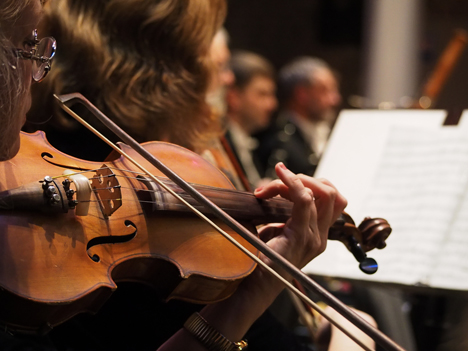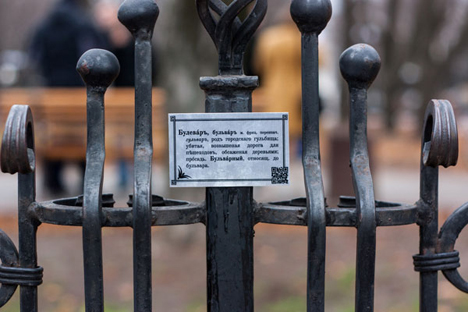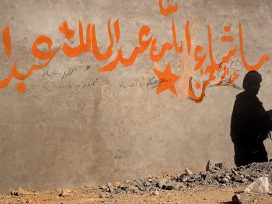Luhansk: The case of a failed cultural revolution
In 2013, the seemingly hopeless task of bringing art to the provinces finally started to bear fruit in Luhansk, eastern Ukraine. One year on, the activists, artists, journalists and writers responsible are exiles in their own country, writes Konstantin Skorkin.
A year ago we all met in Luhansk, at an exhibition of contemporary art in the 10th Shop Floor Gallery. One year on, virtually the same group of people has gathered in Kyiv, at an exhibition which is part of the Donkult Festival. A great many things have happened in the course of that year: the Maidan revolution brought down the Yanukovich regime; Russia’s annexation of Crimea; the bloody slaughter in the Donbass Region and the establishment of unrecognized puppet republics. Over the past year we have lost our native city and our homes and have been turned into exiles in our own country.

Luhansk Symphony Orchestra in concert, 20 February 2014, an event to remember the losses on the Maidan in Kyiv. Photo: IgorGolovniov. Source:Shutterstock
By “we”, I mean activists, artists, journalists and writers from Luhansk. Many of us have dedicated much of our lives to a cultural transformation of our native city.
2013 was a momentous year for Luhansk’s cultural life. It launched a trend that began to turn our city, formerly a key industrial centre in the region, into a cultural hub. In the course of this year the seemingly hopeless task of bringing art to the provinces finally started to bear fruit.
The year was rich in cultural events. It saw the first attempt to transform a former industrial object into an art cluster, with an art centre opening on what was formerly the 10th floor of a shoe factory, named after the space’s former role. A coalition of NGOs working in the arts (and initiated by an organization known as STAN) in conjunction with the leaders of the relevant city council department, started to develop a cultural strategy for the city. The local ethnographic museum held a contemporary art residency entitled “The De-hermetization of the museum universe”. The Luhanda House Audiovisual Arts Centre put on film screenings and electronic music festivals. The Luhansk Architectural Association laid the foundations of public control over the city’s historical centre and started cataloguing Luhansk’s historical monuments. Artist Andrei Dostlev staged Luhansk, city-as-dictionary, a unique public art project that involved signs with quotations from the “Explanatory Dictionary of the Live Great Russian language” (1863 onward) by Vladimir Dal, a Luhansk native.

One of many plaques from. Source:Luhansk, city-as-dictionary
A city that had found itself in a spiritual dead end following deindustrialization during the 1990s appeared to have found a new lease of life. The concept of establishing a creative city seemed a perfect fit for Luhansk – after all, many creative city projects were not the result of the overdevelopment of city space but came into being precisely because received notions had been exhausted.
The authors of the new cultural policy set out to Europeanize the city and sow the seeds of European cultural traditions in Donbass soil. The strategy built on the cosmopolitan character of Luhansk, on its cultural and ethnic diversity. Luhansk had the second largest foreign student population in Ukraine, the heterogeneity of its streets was on a par with other large metropolitan areas. Luhansk was by and large a student city. Specifically, it was home to two universities, which generated the human resources necessary for a cultural transformation.
Due to its geographical position, Luhansk is at the crossroads of Europe and Russia, of the Ukrainian- and Russian-speaking cultural spheres. Its frontier town character gave the impetus for further transformations; located as it is in the field of attraction of both Russian and Ukrainian culture, the city could draw on the best in both cultures.
Of course, forces pulling in the opposite direction had existed all along – for example, the official rhetoric of the city authorities remained extremely conservative notwithstanding the course of European integration steered by the then ruling coalition. The pro-Russian reactionary forces with their “Eurasian” and “Russian world” ideological orientation strengthened their position. Yet in light of the euphoria of the cultural revolution, all this seemed an insignificant vestige of the past, one we had successfully conquered. Looking back it is clear that we – the actors of the transformation – underestimated the power of social inertia, of the authoritarian tendencies, xenophobia and intolerance, as well as the extent to which Soviet stereotypes were still rooted in mass consciousness.
Even during Euromaidan, which received a hostile reception from most of the city’s inhabitants who saw it as a “nationalist” rebellion, the impetus of striving for positive change was still felt in Luhansk. By comparison with the bloody clashes between Maidan opponents and supporters in Kharkiv, Donetsk and Dnipropetrovsk, the political conflict in our city appeared relatively civilized. Local Maidan supporters and their adversaries often held rallies facing each other, with neither side resorting to violence.
However, these events proved to be a mere prelude to the outbreak of separatism in the spring of 2014. Many were unpleasantly surprised at the unexpected violence and aggression of this movement, as well as the widespread support among the local population for separatists who were ready to take up arms early. Pro-European activists found themselves in the firing line and nearly all of them were forced to leave the city after receiving death threats; some were detained and tortured in the separatists’ torture chambers, for example the cultural activist Aleksei Bida and the artist Slava Bondarenko. By the end of the summer of 2014, the city was wiped clean of all signs of the formerly burgeoning European culture and increasingly sunk into a new barbarism.
What happened in Luhansk can, in essence, be described as a serious breakdown in the Europeanization process. Alas, the veneer of culture proved to be too thin and was swept away by the conservative part of the population, with the encouragement of local elites and Russia’s direct influence. The transformational impulse brought about a fierce reaction.
Luhansk is now a city in distress, experiencing the terrible trauma of war in addition to the previous traumas caused by the city’s deindustrialization and the breakdown of traditional forms of life tied to the cycles of big industry. The city has wasted its cultural potential as the destruction wrought by war has brutalized public life, which is now focused on basic survival; the hardening of the population has destroyed the tolerance of diversity that was once its hallmark. Present-day Luhansk has been crushed and torn to pieces. The darkest spectres of the past – such as a total absence of respect for the rule of law, the expropriation of property and the untrammelled violence from the early years of Bolshevik power – have been revived; the population lacks legal protection from terror and lives in an atmosphere of aggression and denunciation reminiscent of the Stalinist period and the gangster anarchy of the 1990s.
Is there a moral in this story? Coming face to face with irrational, elemental resistance to change is always astonishing. The people who supported the separatist rebellion doubtless believed in some kind of truth and idealistic motifs of their own; however, I find it difficult to understand them no matter how hard I try to get my head around the oppositionists’ way of thinking. In the history of mankind we have witnessed similar kinds of rebellion against progress and many a great mind has tried to understand the phenomenon of the flight from freedom and resistance to change.
One thing is for certain: culture has suffered a defeat in Luhansk. However, we, the bearers of culture are still around, scattered around the country and the world. We are not about to surrender or to give up our city, even though it has cast us off. We shall definitely be back one day.
Published 1 December 2014
Original in Russian
Translated by
Julia Sherwood
First published by Eurozine
Contributed by Transit © Konstantin Skorkin / Transit / Eurozine
PDF/PRINTPublished in
In collaboration with
Newsletter
Subscribe to know what’s worth thinking about.
Related Articles

An emotive rift exists between being drafted and signing up for military service. Those who prioritize family responsibilities, education and skills, and non-violence aren’t backing the opposition. Defence comes in many forms. Could lessons from Ukraine’s mobilization inform the recruitment challenges potentially facing the rest of Europe?

For those who suffered the consequences of Yalta’s division of Europe, the Helsinki Final Act brought grounds for optimism. Today, as Russia’s regressive war on Ukraine reopens old conflicts, it stands as a monument to European modernity.





